#hillfolk magic
Text
I don’t have the willpower for a real post at the moment but if you’re trying to deepen your connection to the spirits of the land on which you live, I recommend visiting the following locations:
Nearby bodies of water
Nature trails and forested areas
The highest and lowest points, both natural and otherwise
Community cemeteries and memorials
Places of worship
Other prominent landmarks and characteristic sites
Bring field guides, maps, and brochures if you can find them. Study the topography of the area, note how they relate to other parts of the town, how they are accessed by travelers. Can you get there by car, or did you have to approach on foot? Is it within walking distance of your home? What plants do you recognize? Critters? What’s the history of each site, who lived here before?
Visit each place at different points in the year. The sun slants through the trees differently in spring than in fall, this trail is inaccessible in the winter, the river always floods when it rains, if I cut through the graveyard on my way home I can grab a couple fallen branches from that cyprus by the gate. Leave offerings, say prayers, speak to the spirits.
723 notes
·
View notes
Text
The Regions of Kishetal
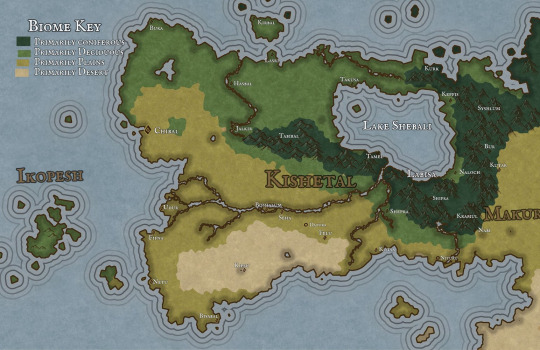
Pictured Above: An environmental map of the land of Kishetal

Pictured Above: A map of the 7 Kishic Regions
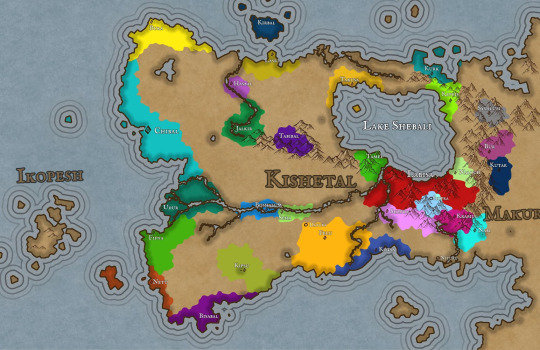
Pictured Above: A map of the Kishic City-States and their territories
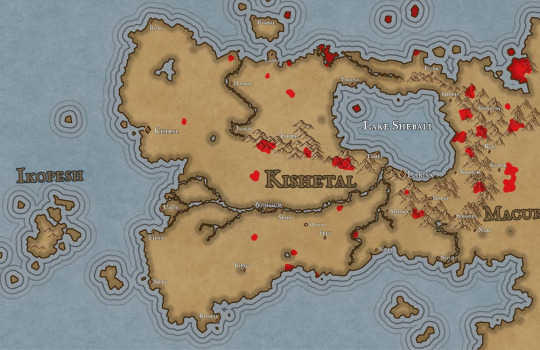
Pictured Above: A map of Significant Stable Forestfolk Populations
Here is a quick overview of the regions of Kishetal, the homeland of Narul and Ninma. And some good ol' maps. I'll be posting in the future about some of the creatures and forestfolk mentioned below!
As always send questions please!
Continues below the cut!
The Regions of Kishetal
1. The Red Cedar Mountains
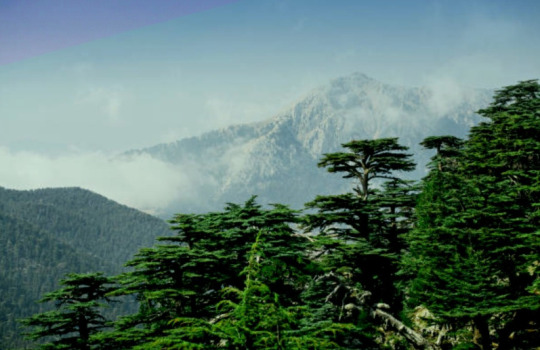
Pictured Above: The Red Cedar Mountains near Kepfis
The Red Cedar Mountains stretch from the Shabalic Sea in the north nearly to the Sea of Agitu in the south. The Red Cedar Mountains were formed in ancient times having already been present in the Age of Metal and Glass. However, the Red Cedar Mountains are not among the eleven “Chains of Sanctuary,” those mountain ranges around the planet in which humanity sheltered from the wrath of the gods during the Calamity. The predominant underlying stone of the RCM is limestone, with occasional but significant areas and deposits of serpentinite, basalt, and dolerite. The region experiences warm summers and cold winters, often with considerable snow and rainfall, particularly at higher elevations. The Mountains surround Lake Shebali, which acts as an inland sea and a source of food and transport for much of eastern Kishetal. At lower elevations, such as Labisa, the predominant vegetation is juniper and oak. Forests of black pine, cedar, and fir are dominant and common at higher elevations. The highest peaks are home to alpine meadows. Wild grapes, figs, and olives are all abundant in this region alongside their domesticated cousins.
Some fauna include wolves, jackals, wild goats, giant minks, wild bulls(aurochs), leopards, kishic lions, kishic tigers, caracals, roe deer, gazelle, wild boar, eagles, storks, horned rabbits, kishic brown bears, lynxes, and kishic ibex.
Very rarely found is the Kishic Elephant, actually a species of mammoth, these tiny pachyderms are about the same size as the average dairy cow. Only about 100 still survive in sheltered valleys to the north.
Examples of monstrous and magical Fauna including Flesh-eating deer, kiriki, dorasi, and the kutiri. While there are rumors of larger monsters such as dragons, these are mostly little more than legends and folklore. Though there is no telling what creatures could be hiding in the many caves and tunnels which dot the mountains.
There are numerous small forestfolk tribes which live in isolated areas.
(I will post more about that later)
2. The Felic Plain

Pictured Above: The Felic Plain north of Boshalum
The Felic Plains primarily consist of grassland with occasional patches of deciduous forest. The area is famed for its almond trees and its many wildflowers, including wild roses and hasir flowers. During the fall, great patches of the plains turn red with the blooming of hasir flowers.
The region experiences hot summers and mild but wet winters, which makes the region ideal for farming. As such, the Felic Plains act as the bread-basket of Kishetal. The region is split by the Aratshin River, which extends from Lake Shebali to the Green Sea. The plains are disrupted by an especially dense forested area known as the Garden. All attempts to settle the Garden have failed.
Fauna include, wolves, jackals, gazelles, wild bulls, kishic lions, deer, eagles, storks, horned rabbits, kishic brown bears, foxes, wild goats, polecats( which are popular pets), felic falcons, and hyenas.
The plains are home to several monstrous/magical species, including Flesh-eating deer, garudu, takmek, and the Unturu Serpent.
There are a handul of forestfolk tribes as well as a single hillfolk tribe in this region.
3. The Western Coast
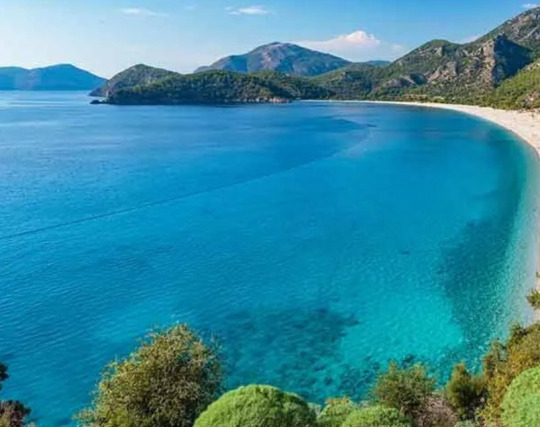
Pictured Above: The Western Coast near the city-state of Chibal
The Western Coast borders the Green Sea stretching from Bura in the north to Bisabal in the south. The ecoregion has a warm semi-tropical climate akin to a Mediterranean climate. Winter is the wettest season, and summer is the driest.
The Western coast consists primarily of three biomes. The deciduous forests in the north consist primarily of hornbeams, oaks, maples, cedar, and black pine. The central marshlands surrounding Udur have heavy concentrations of reeds, papyrus, poplar, and willow. The southern plains are similar to the Felic plain region though typically arider. Bay, olive, carob, and sweetgum are all common in this region. The Green Sea and its coast are home to many kinds of edible seaweed which form an essential part of the Chibalic and Buric diets.
Fauna include wild boars, foxes, jackals, wolves, badgers, wildcats, coastal brown bears, gazelles, deer, wild bulls, wild goats, and storks. Marine life includes dolphins, seals, whales, sea turtles, and many species of fish.
Monstrous fauna include bulari, sea-dragons, serpents, krinari, and ramitalek.
Aside from Ikopeshi's there are no surviving forestfolk tribes in this region.
4. The Northern Coast/Sheprian Forest

Pictured Above: The Sheprian Forest near Shepra
The Sheprian forest in the northern part of Kishetal is primarily composed of deciduous trees with occasional conifer patches at areas with higher elevations. Common trees include oak, chestnut, birch, hornbeam, black pine, cedar, and beech.
The climate is temperate with warm dry summers and cold wet winters. The north is typically thought of as the wildest region, with most city-states and settlements, including Shepra, clinging to the Corin river. Sheprian poetry is a unique variety of poetry, similar to the Japanese haiku, which originates from the forest festivals of the northern coast.
Fauna include wolves, jackals, gazelles, wild bulls, kishic lions, deer, eagles, storks, horned rabbits, kishic brown bears, foxes, wild goats, giant minks, horned rabbits, wild sheep, eagles, and kishic leopards.
Monstrous fauna include flesh-eating deer, garudu, kiriki, dorasi, and winged tigers.
This region contains the second highest concentration of forestfolk after the Red Cedar Mountains.
5. The Southern coast

Placed Above: The Southern Coast near Bisabal
The Southern Coast consists of three regions; the southern deciduous forest, the scrubland, and the plains. The climate in the south is quite warm, with summers being hot and dry and winters mild in both temperature and rainfall. On rare occasions, the southern coast may experience heavy snowfall.
Major cities are sparse however, many villages dot the southern coast, many of these villages rely on piracy, preying primarily on Apunian and Jezaani ships traveling to and from the Western Coast.
Limestone plateaus and outcroppings are near the border of the southern coast, and the desert are said to be the remains of ancient buildings though this is not true.
Poplar, olive, bay, carob, almond, oaks, and umbrella pine are all common.
Fauna includes wolves, jackals, gazelles, wild bulls, kishic lions, deer, eagles, storks, horned rabbits, kishic brown bears, foxes, wild goats, polecats, felic falcons, kishic leopards, and hyenas.
The south is home to relatively few monstrous/magical species though it is home to the largest population of kiriki in Kishetal.
There are only two forestfolk populations in this region.
6. The Kipsian Desert
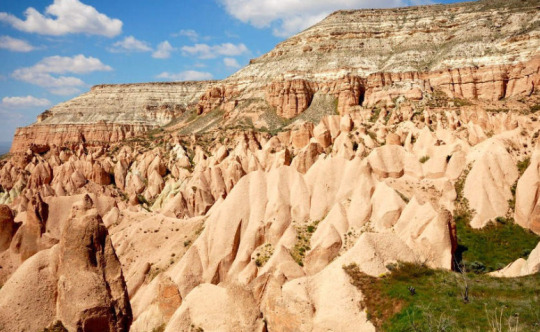
Pictured Above: The limestone formations of the Kipsian desert south east of Kipsu.
The Kipsian desert is the least populated region of Kishetal as the arid environment is not conducive to agriculture. Ruins of older civilizations suggest that the area may have once been more hospitable.
Plant life is sparse and largely limited to hardy shrubs and grasses. The region is famous for its carob and the candies and sweets produced from the carob by its inhabitants. Mesa, plateaus, pillars, and other stone structures are common; foreign visitors often visit the region seeking religious or spiritual enlightenment amongst the arches and columns. Many never leave.
Fauna include jackals, gazelles, kishic lions, deer, gazelle, wild asses, and hyenas. The Kipsian desert is also the only region in Kishetal in which the kishic ostrich and oryx survive.
Monstrous fauna include Flesh-eating deer, takmek, sikara, kiriki, and giant lions.
There are no forestfolk populations here.
7. The Makurian Steppe
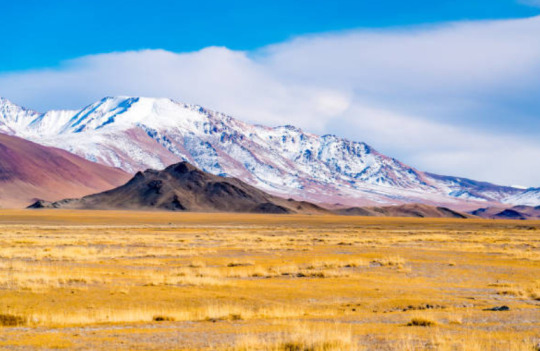
Pictured Above: The Makurian Steppe north of Shebal
The Makurian steppe is massive, spreading over most of western Masia. Only a tiny sliver of that vast extent falls in Kishetal. Trees are almost entirely absent. Vast expanses of grass-covered hills define the area. To the north of the steppe is the Shabalic forest, and to the south is the Jezaaic desert.
The heavy presence of sagebrush, sedges, and grasses and the relatively dry climate have led to a preference for a nomadic and pastoralist lifestyle. Makurian tribes regularly raid and intrude in the region, with their westward pushes typically being halted by the mountains.
Fauna include wild horses, wild asses, wild bulls, jackals, gazelle, deer, mountain sheep, macuri lions, and leopards.
Monstrous fauna include the tomob and the wulut.
There are only 3 native forestfolk populations in this region.
As always ask questions! Anything! And if y'all like this I might do this with some other regions.
@patternwelded-quill @flaneurarbiter @skyderman @blackblooms @roach-pizza @illarian-rambling @dezerex @theocticscribe @axl-ul, @persnickety-peahen @angie-j-kay
@surroundedbypearls I was looking through my intro post and I just realized I've been completely forgetting to put you in the taglist! Sorry about that!
#writeblr#writing#fantasy#worldbuilding#writer#fantasy writing#queer fantasy#fantasy world#testamentsofthegreensea#fantasy map#fantasy novel#fantasy worldbuilding#world building#narul#writblr
53 notes
·
View notes
Note
re: Appalachian Witchcraft for Beginners
^jsyk where my ask stems from.
you said the author is one of few that mentions red clay and i was wondering if you knew of any of the others and if their info or themselves were reliable? i’m sorry if this isn’t worded well.
Hello there!
These are my own opinions mind you, and I can understand if some of these authors aren't everyone's cup of tea.
Personally for written information on Appalachian Folk Magic available to the modern public I do recommend:
Jake Richards -He has some controversy about him, so do with that what you will but a lot of what he talks about I have seen within my own family so I would say a lot of the information is pretty solid. Do take some stuff with some salt as some of what he talks about borders on proper Hoodoo.
New World Witchery- Cory Thomas Hutchenson. This covers a lot of folk practices from around America but the real treasure is the giant pile of resources in the back of the book.
Southern Cunning- Aaron Obreon. This covers more southern based cunningwork/folkloric witchcraft. This book is a breakdown of the far too expensive in my opinion...Silver Bullet, a folklore book from ages gone by. Can still be followed without the other book!
Roger J. Horne- All of his books kind of blend Traditional British style magic with folkloric based Appalachian work. I find the way he describes witch's flight and how he breaks down complicated ideals a great resource. But only if you are interested in both topics.
The Foxfire Series- A great series about Appalachia and things within it, both folkloric and way of life. I personally love the book: Boogers, Witches, and Haints in the series for folklore to dig into and apply to your own practice.
H. Byron Ballard- Another slightly controversial author, I adore the way Ballard describes the mountains and the natural magic and energy that's here. She makes me feel homesick and I live here! Seeing her speak in person really solidified my fondness for her works. The only thing I hate is she calls AFM "Hillfolk Hoodoo" which the term does make me sigh every time I read it.
(This title is laughable but I swear this is a historical remedy book that is fairly good!) Egyptian Secrets of Albertus Magnus- Remedies of the old days, was one of those books like "Long Lost Friend", but this one I have heard of some AFM workers using in the older days.
Southern Folk Medicine: Healing Traditions from the Appalachian Fields and Forests - Now I will always say please go to a doctor for any ills, but herbalism and remedies are an important part of AFM, just use it in conjunction with a doctor's advice and medication. (AND ASK THEM ABOUT IT PLEASE.) This particular book really focuses on some of the older concepts of the "blood types" that did play a somewhat important role in older ideals of illness and injury here.
Power of the Psalms by Anna Riva- Okay look. Having a Psalter, a list of Psalms and their uses is SUPER IMPORTANT TO ME. This one is always by go to, otherwise I do like Gemma Gary's Psalter as well. Great for workings, and also great to help you memorize certain Psalms that can and will spook those really overbearing and ridiculous Christian types that try to insult you in some way.
That's all the ones I can think of at the moment but I might think of some more eventually!
68 notes
·
View notes
Text
im dumb but I’ve only recently started to understand a big reason I’ve hardly made many witch friends is because so many people are outside of magic trying to get in and learn HOW and I was born of magically inclined hillfolk, trying to learn WHY and WHEREFROM and its very hard to relate over witchcraft and the like when priorities differ. I like to discuss theory and precedent more or less for its own sake and most people I meet discuss those things from a frame of pursuit of results and like... I don’t need better magic. I need community. I need stimulus and satisfaction of an innate curiosity about other forms of it and where different people believe it comes from. It’s an odd position to be in to feel like you already know what you’re doing when most folks ask questions for different reasons and many decide your differing background means you’re somehow in a position to teach them when you’re literally studying *them*. There seems to be a very tutorial-hungry contingent of folks that tend to see any form of study as a way to harvest power and that’s so ass-backwards it’s no wonder anti-intellectualism and cultish behavior is so rife among the alleyways of the magical community because of course it would be when nature functionally is incapable of waste and there’s this huge body of people acting as a resource to fuel the megalomania of the unscrupulous and drive off the wary because for them inquiry is only an expression of a desire to incorporate new methods and runs the risk of killing the “magic” if they can see the wizard behind the sheet because for whatever reason they need that romance to maintain its mystique, but that’s not the only function inquiry can serve in the context of a community of people originating in different currents. Not when most people think we’re cracked for even believing things go bump in the night let alone having a full spice rack of materia with which to deal with those very things and names to call them as well.
13 notes
·
View notes
Text
The Silver Circle Character Intros!
I figured it's about time I posted one of these, so I'm doing it for the WIP I've been working on the most! These are just going to be little snippets about each character, so read on if you're interested in my writing or in fantasy wips in general!
Apologies for the delay for those who saw my other post about this, I’ve been BUSY.
Also, I'm going to be keeping this to the core cast for now. Keep in mind this is them as we start the story! Things here can and will change over the course of the book.
The Good Guys
Bran Brightwood - orphan taken in off the streets by Apprentice Librarian to Orulin the Wise, a powerful and ancient wizard. He's been living in the Tower of , keeping things tidy in exchange for a place to live. He picks up bits and pieces of magic from the wizard that runs the place, whenever he’s in. He’s a bit nervous around people, having spent most of his youth and the first year of his adult life in the Tower, and prefers to let his best friend Arryn do the talking. A human, he’s not particularly attuned to any of the cool fantasy stuff going on, but damned if he’s not interested in it. Has read more books than medically advisable.
Arryn - Pickpocket, master attempter of stealth, Bran’s best friend, general moron. We love him. He’s been looking after Bran for as long as either of them can remember, and when Bran got taken in, Arryn insisted they were a package deal. After some pleading from Bran, Orulin accepted on the grounds that Arryn not be allowed to touch anything, ever. When that didn’t pan out, for obvious reason, Arryn’s restrictions loosened, though he wasn’t allowed into the Archives. That’s fine by him, though, as he prefers to spend his days down at the tavern or exploring the city.
Kyra - A young half-Drakarran in training to become a Pale Warden. Her Mentor, Torren, has trusted her with a solo mission to help an old friend of his. She's eager to prove herself, especially as one of the few Drakarrans in the Wardens, but retains a sense of superiority around non-Wardens. Her work, she reckons, makes her more important and useful than her traveling companions. Mutual hatred shared with Arryn because of this.
Throgg - An Ular mercenary recently discharged from the Iron Fang, a guild of monster hunters. He spends most of his days at the Hawk and Bishop tavern, taking on whatever work he can find. Owes Orulin a life debt, though as more time passes without the wizard calling on him to repay it, the more unsure he is about their deal. Big old grump, unless he knows you. Then he's just a regular grump.
Aelar Lorhalien - Bright Prince of the Caeloran Dominion, an ancient Aetheri kingdom that’s recently had a coup under new management. He’s come to Orulin, an old traveling companion of his, for help. Obsessed with the history of his people, Aelar has devoted most of his century or so of life to the study of the mysteries of the Aetheri people, particularly interested in the pre-Aether times. He’s a bit snobbish and out of touch with the outside world, but Aelar is fiercely loyal to people who make themselves his ally.
Lucian Arkalis - Master Wizard, Veteran Adventurer, and former apprentice to Orulin, Lucian is a bit of a loner. He studies applied magics in his effort to help his teacher unravel the mysteries of the Aether. Not ostentatious like some other wizards, he keeps his robes and staff simple. Spends most of his time traveling, as he believes magic is best used in active help of others.
Twilly Whindlespring - Born to Hillfolk parents in a Stonefolk kingdom, Twilly is a product of both cultures. Her Stonefolk upbringing taught her to speak her mind, possibly at inopportune or inappropriate times, but her Hillfolk culture reminds her to always be chipper about it. Picking up a love of cartography from her father, Twilly is on a quest to create the first-ever map of the entire world. She won’t let anything stop her.
Trenton Stoneroot- Ser Trenton Stoneroot is a knight. Mostly in name, as his father is the Duke of Ravencrest, the northernmost bastion of the Felean League. He’s noble, reliable, maybe a little too trusting, and dreams of one day becoming one of the Kingsworn, the High King’s most trusted and skilled personal guards.
The Bad Guys
The Children of the Forgotten One - a cult worshipping an old, dead god. One they are not supposed to remember. They will not rest until everyone does. The lucky among them are granted incredible powers and equipment to aid them in their goals. The less fortunate become Forgotten: warped, mindless creatures bent only on destruction.
Astrid - the Cult’s foremost political asset. Has infiltrated the Felean League’s High Council and works from the inside, unbeknownst to any of our heroes. Incredibly brilliant and almost supernaturally persuasive. The head of the operation.
Gabriel - Forgotten General. Leads and gathers a supernatural army for his god. Is the most religious of the big 3 villains, and is a zealot for the cause. Will do anything and kill anyone that gets in the way of his divine mission.
Donovan - Mercenary leader of the Dragon’s Ire, a group contracted by Astrid to carry out more discreet operations. Not too big on the cult stuff, but the coin’s good, and a place in the new regime ain’t too bad, either.
That’s it for now! I tried to keep it short, this went on way longer than I meant it to lol. Like I said, feel free to ask any questions!
Edit: Oh, and for anyone curious what I mean when I say Aetheri, Ular, Drakarran, etc, check out my second answer here!
8 notes
·
View notes
Photo
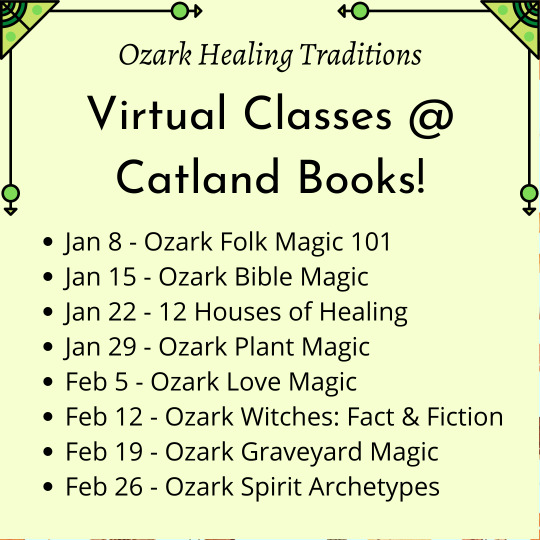
I’ve got another series of virtual classes coming up at Catland Books NYC! For more information and to purchase tickets, follow the links below.
January 8 - Ozark Folk Magic 101 @ Catland Books (Virtual)
Time: 6-8pm (Central) 7-9pm (Eastern)
Location: Virtual
Purchase Tickets Here
A general overview of folk magic rites, rituals, and spells, from an Ozark point of view. A great class for beginner witches and folk magicians as well as seasoned practitioners wanting to brush up on their foundational practices and considerations. Specific areas that this class will cover include:
Foundational Ozark worldview and the relationship between humans and magic.
Interactions between the Human Realm and the Otherworld.
Magical considerations that form the basis for Ozark rituals e.g. auspicious timing, locations, and repurposing household objects for magic and healing.
Materia of Ozark folk magic with a focus on plants and non-plant-based ingredients, tools, and other items.
Each topic will include practical guidance as well as rites and rituals specially formulated for this class.
All classes are recorded. A link to the recording is sent out to the ticketholders the day after each event. These links stay active for 30 days.
January 15 - Ozark Bible Magic @ Catland Books (Virtual)
Time: 6-8pm (Central) 7-9pm (Eastern)
Location: Virtual
Purchase Tickets Here
Along with the almanac, the Bible was often the only book owned by Ozark hillfolk until the modern era. At one point in our past, the Bible was the source not only of spiritual teachings, but also a combination reading primer, divinatory system, and spell book.
We will be looking at the position the Bible has held in Ozark traditions of healing and folk magic. In many cases, hillfolk families might not have had a spiritual connection to the Bible but still recognized the text as a valuable text for working magic in the world. We will be looking at verses and passages that have long histories of use in the Ozarks for specific purposes like healing, protection, retribution (or cursing), as well as love and money magic. We’ll also look at rituals that have developed amongst hillfolk using these biblical texts as well as using the Bible itself as a divinatory tool as well as a protective amulet.
All classes are recorded. A link to the recording is sent out to the ticketholders the day after each event. These links stay active for 30 days.
January 22 - Twelve Houses of Healing @ Catland Books (Virtual)
Time: 6-8pm (Central) 7-9pm (Eastern)
Location: Virtual
Purchase Tickets Here
The figure of the “Man of Signs” or “Zodiac Man” serves as a foundational guide for most traditions of Ozark healing and magic. This figure was often committed to memory, but could also be found in the home almanac (and it is still printed in the major farmers’ almanacs today.) In Ozark healing theory, the primary effect of illnesses (physical or magical) is that they force the Twelve Houses of the body and their associated signs out of balance. This creates disharmony and manifests as bodily symptoms. Bringing the body back to equilibrium is therefore the main goal of the traditional healer. The main tools in their satchel are divinatory methods aimed at finding the exact location (Zodiac House) where the illness or hex is rooted in the body. Knowing this then provides a plethora of correspondences that can be “countered” as part of the healing process.
We will be looking specifically at the role of the twelve bodily houses in the healing process, how healers and magical practitioners diagnose these houses, and methods for correcting imbalances in the houses using elemental and zodiac correspondences.
All classes are recorded. A link to the recording is sent out to the ticketholders the day after each event. These links stay active for 30 days.
January 29 - Ozark Plant Magic @ Catland Books (Virtual)
Time: 6-8pm (Central) 7-9pm (Eastern)
Location: Virtual
Purchase Tickets Here
The Ozark region is prized for its biodiversity and at times throughout history has even been targeted by researchers and herbalists alike because of its many healing plants. In this class, we will look at the most important plants for Ozark practitioners, both for their medicinal and magical values. We’ll examine how the relationship between practitioner and plant spirits have developed into the modern area. And of course, we’ll take a look at specific traditional herbal remedy recipes from the region as well as a few spells using amazing mountain botanicals like the “Holy Trinity” of Ozark plants: red cedar (Juniperus virginiana), sassafras (Sassafras albidum), and tobacco (Nicotiana spp.).
All classes are recorded. A link to the recording is sent out to the ticketholders the day after each event. These links stay active for 30 days.
February 5 - Ozark Love Magic @ Catland Books (Virtual)
Time: 6-8pm (Central) 7-9pm (Eastern)
Location: Virtual
Purchase Tickets Here
A controversial area of magic, even amongst traditional folk healers and magicians. In the Ozarks, love magic was once as necessary as work for healing and fortune. Today, love magic continues to pique the interest of those looking to folk magic practitioners for help. Ozark hillfolk have both inherited as well as developed a rich relationship with magical practices aimed at the heart. Everything from divination rituals to locate your true love, to fashioning love-drawing (or sex-drawing) amulets, to ritual methods of healing, binding, and breaking relationships.
We will look at Ozark love magic divided into three main categories of 1) divination 2) amulets, and 3) ritual work. We will be looking at specific spells and methods from both the much older folk record as well as how modern practitioners have approached and evolved love magic today.
All classes are recorded. A link to the recording is sent out to the ticketholders the day after each event. These links stay active for 30 days.
February 12 - Ozark Witches: Fact & Fiction @ Catland Books (Virtual)
Time: 6-8pm (Central) 7-9pm (Eastern)
Location: Virtual
Purchase Tickets Here
Witchcraft has occupied a controversial position in the Ozarks since the first white settlers came to the region in the early 1800s. For many, there is a firm separation between the role of the witch, who is said to always do harm, and the healer, who is said to always do good. Many other magical practitioners of the past and present have occupied a much more neutral area and have used their gifts to both give and take away. For these individuals, the role of the healer or gifted individual in the community is likened to nature itself, which exists outside our human conceptualizations of “good” and “evil.”
We will examine the many sides of this complicated story, from the point of view of proud witches themselves to the old tall tales and legends about broom-riding grannies and child-stealing hags. We'll try and separate some facts from the fiction and even throw in a spell or two you can use at home.
All classes are recorded. A link to the recording is sent out to the ticketholders the day after each event. These links stay active for 30 days.
February 19 - Ozark Graveyard Magic @ Catland Books (Virtual)
Time: 6-8pm (Central) 7-9pm (Eastern)
Location: Virtual
Purchase Tickets Here
The graveyard has always been an important part of Ozark folk magic traditions. In the old days, this was where a witch could be born from an ordinary human and where the “veil” between worlds was constantly thin. Graveyards aren’t just for the spooky ritualist, however, and have traditionally been a site for the work of Ozark healers as well. For many mountain practitioners, historic and modern, healing work includes not just serving the living but also the dead. These shades often figure as guides, guardians, patrons, and ancestral helpers in many healer stories as well as aids in the process of healing or “elevating” the restless dead as well.
We will be examining Ozark folklore situated in the graveyard as well as look at some of the many ways healers and other magical practitioners have incorporated this all-important work with the dead into their own lives and rituals.
All classes are recorded. A link to the recording is sent out to the ticketholders the day after each event. These links stay active for 30 days.
February 26 - Ozark Spirit Archetypes @ Catland Books (Virtual)
Time: 6-8pm (Central) 7-9pm (Eastern)
Location: Virtual
Purchase Tickets Here
Ozark verbal charms and prayers often invoke archetypal figures as helping spirits in the work at hand. These archetypes are seen as being far more predictable in their correspondences than individual spirit entities, who often have their own goals and desires that might not align with the magical practitioner’s. Some of these spirits are metaphorical individuals, for example, invoking the figure of Prosperity in a ritual seeking aid for the success of a business or job. Others are figures found throughout Ozark folklore like the character of Clever Jack (of beanstalk fame.) And it is these folkloric archetypes that we will be examining in this class, seven in particular: The Fortunate One, Clever Jack, Green Thumb, The Aunty, Mother Mary, Silver Eye, and Old Scratch.
All classes are recorded. A link to the recording is sent out to the ticketholders the day after each event. These links stay active for 30 days.
#ozarks#traditional witchcraft#witchcraft#folk magic#witchythings#folklore#Ozark Folklore#ozark magic#ozark folk magic#ozark folkways#ozark healing traditions#healing#spiritual healing#traditional healing#traditional medicine#magic#spiritism#spiritualism#Spirits
22 notes
·
View notes
Photo

Hiraeth Creature #1203 - Lughirus
“Traveling with the stars and through the narrow path will lead one to the realm where the worldly spaces grow, making room for titanic beasts and warring giants. In this place, the earth resonates with the stomping of limbs and the winds part for echoing roars. Many would think this place a fantastical nightmare: fascinating, yet horrifying, no place one would wish to visit. While many would never dream to enter the Land of Giants, there are those who make pilgrimage to test their mettle and cultures who call this realm home. Witch covens, barbarian clans, and even convents of clerics have made lodgings in the shadows of primal forests, all to be closer to the celestial energies that coalesce in the Land of Giants.
From a Ravenous Beast who descended from the celestial sea, the first Giants were born, carrying her cosmic essence. As they lived and fought with one another, another creature was shaped by their conflict. Small insects who drank Giants’ blood, laced with celestial magic, turned into massive beasts of proper scale and majesty. Known as Lughirus, they went from bottom of the food chain to a contender, able to do battle with giants.
Both Lughirus and Giants wield celestial magic, but the Lughirus channel it in unique ways, able to spark wild energy from the tip of their proboscis and call forth great lance-like pillars of starlight in a furious barrage. These pillars devastate any who fall under them but take time to crumble away and, as they do, their powder of starlight is said to heal the land they fall upon, restoring fertility and flora. Mighty Hillfolk warriors and champions of celestial magic seek out the blessing of the Lughirus, who can bestow this volley of light unto others. An offering of Giant’s blood must be fed to a brood of Lughirus nymphs, and then their mother would grant the spear-point mark from her bite. The process is said to be painful, but only for a moment, and then the bitten will be able to call forth a celestial art of immense power.”
35 notes
·
View notes
Note
Here goes:
What's your least favorite trope/feature/whatever in stories about witches/wizards/magic practitioners?
Hey there! You get a list.
Wicca = witchcraft or witchcraft = Satan. I hope I don't have to explain this one.
"Witch" and "wizard" being used as gendered versions of each other. The connotation is vastly different for each word!
Snide wizard figures. We are not wise, we are setting our beards on fire in the towers because we got too close to the exploding thing.
Also, not all of us have towers, I want more swamp people wizards. More hillfolk wizards. More wizards who live on the plains. Wild West Wizards.
There's probably more, but I have a splitting headache and bad Internet, so I'm gonna go chug some water.
~Jasper
8 notes
·
View notes
Text
Appalachian Granny Magic
A mix of Scots-Irish magical traditions and regional rituals of the Cherokee Indians (known then as Tsalagi), adherents of this practice referred to themselves as witch doctors or water witches, depending on their given specialties such as dowsing, ley lines, healing, charms and energy vortexes. Granny Magic was passed down from parents to children, staying in the family as a way of strengthening ties. These witches fared better than most would expect, their services valued particularly among new mothers.
Remedy and divination were these grannies’ calling cards, “hillfolk hoodoo” dating back to the 1700s.
0 notes
Text
Staubs And Ditchwater: A Friendly And Useful Introduction To Hillfolk's Hoodoo by H. Byron Ballard

I really, really liked this book!
So, to allay your worries and mine, H. Byron Ballard spend the first chapter speaking about how the “Hoodoo” she works with specifically is Hillfolk Hoodoo, passed down to her from her grandmother, and the relatives before her, as part of her family line. She outright says that it has no direct connection to the African Diaspora practices that share the same name. Phew! That was super reassuring to me straight off the bat.
Now then:
I did not expect to like this book, but it turns out I really did! I picked it up from the local library as soon as it was available. Since my grandfather was from a northern Appalachian area in WV, and I wanted to know more about what the folk-magic culture there looked like, and this book seemed like a great place to start. It’s quick, since it’s a thin read, has a lot of background on the history and philosophy of the Appalachian spiritual nature, and has a lot of great tips I can’t wait to include.
A lot of portrayals of Appalachian folk magics (I mentioned the one table tipping book in particular) in modern day tend to be tied up in modern conception of what witchcraft does or should look like. This author, however, brought a lot more to the table-- a conversation on assimilation of cultural outlooks versus the potential death of their culture. I found her craft advice really down to earth, I found her perspective on her hillside roots illuminating, and this book was an easy read to burn through, considering it was much lighter than I had expected.
The only thing I did not quite understand was her insistence on dropping the rromani slur a couple times at the beginning of one chapter. She seems to use it to highlight the difference between the stereotype that the slur portrays versus the people themselves, but doesn’t seem to realize quite why one should avoid the word? It was disappointing, but since I do sort of know the area, I do know that its use is historically proliferated in this side of the country...I just wish that, as close to the modern witchcraft community as she is, that she knew the damage the word continues to cause even to this day.
Either way, I found this book a short, but valuable look into Appalachian folk magics. If you're looking for a book on the topic that isn't a thousand pages long, I would recommend this one.
Blessings!
tips?
#growing-yet#witch books#books#witchcraft#traditional witchcraft#folk witchcraft#folk magic#appalachian#appalachian folk magic#hillfolk hoodoo#witches of color
187 notes
·
View notes
Photo

(via The Hillfolks' Hoodoo of Byron Ballard - For Puck’s Sake)
Byron Ballard has called western North Carolina home since her birth at the local Seventh Day Adventist tb sanitarium. Her education includes a BA in theatre and a Master of Fine Arts in the same field. She studies and practices Appalachian folk magic, a traditional folkway that she’s dubbed “hillfolks’ hoodoo.” Her research in its origins has led her to field-work throughout the British Isles. Her books on the subject include “Staubs and Ditchwater: an Introduction to Hillfolks Hoodoo” (Silver Rings Press) and “Asfidity and Mad-Stones” (Smith Bridge Press). “Embracing Willendorf: a Witch’s Way of Loving Your Body to Health and Fitness” (Smith Bridge Press) debuted in 2017. “Earth Works: Ceremonies in Tower Time” (Smith Bridge Press) was released in June 2018. She is currently working on “The Ragged Wound: Tending the Soul of Appalachia.”
2 notes
·
View notes
Text
Major highways also have spirits but most of y’all aren’t ready to talk about that fact.
100 notes
·
View notes
Note
queen!
QUEEN- What is the earliest planned historical event in your WIP?
Ooooh thats a hard one because I'm not entirely sure what they mean by planned historical event.
1. The earliest event within the lore would be the creation of the worlds themselves, the birth of the awakened (humans, giants, tree-tenders, hillfolk, stone folk, etc.), the beginning of the Cycle of Reincarnation, the coming of the first Spiritblood, and the subsequent slaying of the Great Mother Serpent.
2. The earliest event mentioned in detail that was witnessed directly by a character (The Deep Sun a spirit/demon), would be The Great Calamity, in which humans created a technology which allowed them to process magic i.e. life force/souls into energy. The terrifying ecological and magical consequences of that technology, on not only Kobani but in all of the worlds with in the Cycle of Reincarnation, were so severe that the gods themselves were forced to intervene. Civilization was essentially wiped off the face of the planet, ending what people would later know as The Age of Glass and Metal. The main events of the WIP take place thousands of years later, after a new Stone and Bronze age. Traces of magic from the destruction brought on by the technology and by the gods, still lingers in Kobani thousands of years later, creating monsters and the forestfolk.
3. The earliest historically relevant event to take place entirely within the the timeline of the first book, would be the Coup and Usurption of the Throne of Labisa.
bit of a long winded answer but there we go!
#fantasy#worldbuilding#fantasy writing#testamentsofthegreensea#writeblr#keep asking!#thanks for the ask!#ask game
10 notes
·
View notes
Link
‘I once heard of a man who was passed certain charms from his great aunt who, as family legend has it, got them from a man inside of a huge sycamore tree. The first charm came to her when she was hunting for blackberries in the woods. She heard a voice coming from behind a tree and thought it was one of her brothers playing a trick on her. But seeing no one around she stepped closer to the tree and heard the voice again. It was a man’s voice, muffled, coming from within the tree. He taught her one charm each day for ten days then the voice disappeared. She always said the man must have been the ghost of some “Indian” that had died beneath that sycamore tree.’
#yard doctors#witches#granny witches#appalachia#ozarks#initiation#hillfolk#hillbillies#folk magic#folk healing#faith healing#witchcraft
8 notes
·
View notes
Note
For the ask game!
4. 🐈 CAT: Does the world of your WIP have any superstitions or folklore?
🌈 RAINBOW SLOTH: Wild card! Share one thing about your WIP that you have been waiting to be asked about!
🐈 - several! I’m gonna do this for the world of The Silver Circle. The most predominant one to the plot is that the Ular (a race of my own creation) are infected by demons since their homeland is now a barren wasteland called the Hellgate Plains, where a demon portal once opened and threatened the world. The Ular are actually descended from dragons, leading to their horned and tusked appearance, but their colorful skin and fiery eyes lead many to believe their nature is more infernal than they claim.
🌈 - I haven’t really been waiting to be ASKED , per se, but I guess I’ll use this slot to loredump about the different races in my world! I tried not to do the standard orc/elf/dwarf/etc, purely out of challenging myself, so here goes!
Humans - They are humans. You know humans, right? I hope. They’re like that.
Ular - A race of half-giants descended from dragons and a race of long-extinct giants. They’re large, usually anywhere from 7-10 feet tall, have colorful skin, and horns. Some of them have tusks, left over from their giant ancestors, but it seems to be random.
Aetheri - An ancient race of humanoids that were forever changed when their greatest mage conducted a ritual to merge himself with the Aether, the source of all magic in the world. The ones that survived were changed into the Aetheri. Granted extended lifespans and bodies attuned to the Aether, the people rebuilt, growing the Caeloran Domionion that now occupies half of the continent. They tend to be graceful beings, even the larger ones. Roughy the size of a normal human.
Drakarrans - A small cult tried to recreate the experiment that spawned the Aetheri by tapping into dark corners of the Aether. The resulting fallout created a new race, scaled and more fierce. Drakarrans vary more wildly in appearance than Aetheri, often having more monstrous eyes, patches of scales, claws, or fangs. Unlike Aetheri, their skin is usually green or purple. Magic in Drakarrans tends to manifest more destructively, sometimes even uncontrollably depending on the person.
Stonefolk - Cultural cousins of the Hillfolk, the Stonefolk of the North lay claim to being the oldest (un-magically-altered) race on the continent. Though small, their craftsmanship of weapons and armor is nigh-unmatched. They are respected traders and rulers, though they prefer to keep to themselves in the mountains. Due to their cities being so spread out, each city has its own king, effectively forming its own dominion. When the kings come together to discuss matters of great importance, it is known as the Eyr Hanad. Stonefolk found in their homeland speak bluntly and true, with little care for niceties. This causes more conflict than they would care to admit. Their understanding of the Aether is as a tool to be used, a material to be forged. They make incredible magic items and have mastered Rune Script, the written language of magic.
Hillfolk - Though genetically identical to their northern cousins, the Hillfolk could not be more their opposite. They love people, and will frequently insist strangers stay in their homes, as a way of showing hospitality. They’re known for their lavish parties and fine alcohol, and their cities make excellent rest stops for weary travelers. Because of this, they’re very shrewd businessmen, making all of their profit off of trading with passers-through and selling their crops. Where Stonefolk are cold and blunt, Hillfolk are warm and inviting, though they are far more fond of lying and trickery as methods to get their way.
#callahanscorner#writeblr#writblr#my writing#my wip#creative writing#the silver circle#ask game#thanks for the ask!!
6 notes
·
View notes
Note
hi! do you have any books you`d recommend for learning about appalachian folk magic, either as an introduction to practice ? i grew up hearing about both my great-grandmothers being practitioners, but it hasn`t survived in either of my family lines
Byron Ballard is a staple in the genre! She refers to her own craft as "Hillfolks Hoodoo" but makes it very clear early on that she is NOT conflating it with actual Hoodoo practice and is good at pointing out where certain stuff comes from. She also writes a lot about the "cultural strip mining" of the area and how the craft and this area interact with each other. No author is perfect ofc but her stuff is very informative.
40 notes
·
View notes